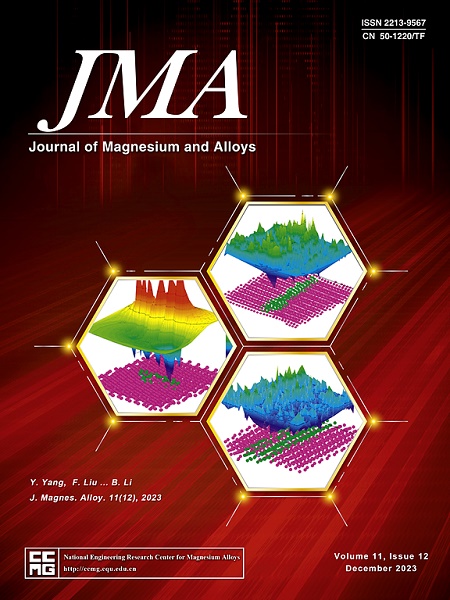Enhancement of the corrosion resistance of the Mg alloy ZW61 by dual-frequency ultrasonic vibration
IF 15.8
1区 材料科学
Q1 METALLURGY & METALLURGICAL ENGINEERING
引用次数: 0
Abstract
Ultrasonic vibration was introduced into the casting of quasicrystal-reinforced magnesium alloy ZW61. The microstructure, mechanical properties, and corrosion resistance were studied. The dual-frequency ultrasonic field (DUF) treatment reduced the α-Mg grain size from 502 µm to 69 µm, and the aggregated lamellar I-phase was refined into tiny dot-like shapes with a smaller area fraction. Static corrosion and electrochemical tests indicated that DUF decreased the corrosion rate from 10 mm·y−1 to 3 mm·y−1 with a denser protective oxide film. DUF not only significantly enlarged the effective cavitation area but also reduced the dependence of transient cavitation on the initial bubble radius. The ratio Rmax3/tc was used to qualitatively characterize the cavitation strength, and cavitation dynamics calculations indicated that DUF had higher cavitation strength compared to single-frequency ultrasonic field (SUF). An equation for corrosion rate versus microstructural parameters (grain size, second phase fraction, potential difference) was developed, which could well predict the corrosion rate of magnesium alloy ZW61 without and with different ultrasonic vibrations.
通过双频超声波振动提高镁合金 ZW61 的耐腐蚀性能
在铸造准晶体增强镁合金 ZW61 时引入了超声波振动。对其微观结构、机械性能和耐腐蚀性进行了研究。双频超声场(DUF)处理将 α-Mg 晶粒大小从 502 µm 减小到 69 µm,聚集的片状 I 相被细化为面积分数更小的微小点状。静态腐蚀和电化学测试表明,DUF 的腐蚀速率从 10 mm-y-1 降至 3 mm-y-1,保护氧化膜更加致密。DUF 不仅显著扩大了有效空化面积,还降低了瞬态空化对初始气泡半径的依赖性。空化动力学计算表明,与单频超声场(SUF)相比,DUF 具有更高的空化强度。建立了腐蚀速率与微观结构参数(晶粒尺寸、第二相分数、电位差)的关系式,可以很好地预测无超声波振动和有不同超声波振动的镁合金 ZW61 的腐蚀速率。
本文章由计算机程序翻译,如有差异,请以英文原文为准。
求助全文
约1分钟内获得全文
求助全文
来源期刊

Journal of Magnesium and Alloys
Engineering-Mechanics of Materials
CiteScore
20.20
自引率
14.80%
发文量
52
审稿时长
59 days
期刊介绍:
The Journal of Magnesium and Alloys serves as a global platform for both theoretical and experimental studies in magnesium science and engineering. It welcomes submissions investigating various scientific and engineering factors impacting the metallurgy, processing, microstructure, properties, and applications of magnesium and alloys. The journal covers all aspects of magnesium and alloy research, including raw materials, alloy casting, extrusion and deformation, corrosion and surface treatment, joining and machining, simulation and modeling, microstructure evolution and mechanical properties, new alloy development, magnesium-based composites, bio-materials and energy materials, applications, and recycling.
 求助内容:
求助内容: 应助结果提醒方式:
应助结果提醒方式:


